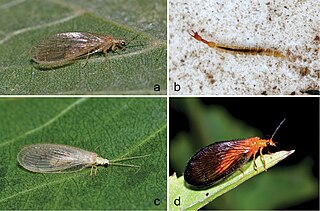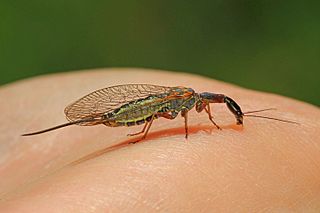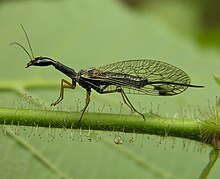
Snakeflies are a group of predatory insects comprising the order Raphidioptera with two extant families: Raphidiidae and Inocelliidae, consisting of roughly 260 species. In the past, the group had a much wider distribution than it does now; snakeflies are found in temperate regions worldwide but are absent from the tropics and the southern hemisphere. They are a relict group and have been considered living fossils, as species from the early Jurassic period closely resemble modern-day species.

Lestes is a genus of damselfly in the family Lestidae. The family hold their wings at about 45 degrees to the body when resting. This distinguishes them from most other species of damselflies which hold the wings along, and parallel to, the body when at rest.

The Nevrorthidae, often incorrectly spelled "Neurorthidae", are a small family of winged insects of the order Neuroptera. Extant species may be described as living fossils. There are 19 extant species in four genera, with a geographically disjunct distribution, Nevrorthus, comprising 5 species with scattered distributions around the Mediterranean, Austroneurorthus with two species known from southeastern Australia, Nipponeurorthus comprising 11 species known from China and Japan, and Sinoneurorthus known from a single species described from Yunnan Province, China. They were at one time placed in the Osmyloidea, with the Osmylidae and the spongillaflies (Sisyridae) as their closest relatives, but nowadays they are considered to be the most ancient lineage of living lacewings. Sometimes they are placed in a suborder Nevrorthiformia, but the quite basal position of the family is probably better expressed by placing them directly in the Neuroptera, without assigning the subordinal rank.

Psychopsidae is a family of winged insects of the order Neuroptera. They are commonly called silky lacewings.

Rhachiberothidae, sometimes called thorny lacewings, are a family of winged insects in the order Neuroptera. The family has only 14 extant species in 4 genera found in Sub-Saharan Africa, but has a diverse fossil record extending back to the Early Cretaceous in Lebanon, Eurasia and North America.

The dustywings, Coniopterygidae, are a family of Pterygota of the net-winged insect order (Neuroptera). About 460 living species are known. These tiny insects can usually be determined to genus with a hand lens according to their wing venation, but to distinguish species, examination of the genitals by microscope is usually necessary.

Alderflies are megalopteran insects of the family Sialidae. They are closely related to the dobsonflies and fishflies as well as to the prehistoric Euchauliodidae. All living alderflies – about 66 species all together – are part of the subfamily Sialinae, which contains between one and seven extant genera according to different scientists' views.
Hyperamoeba is a former genus of amoeboid protists, described in 1923. It has been shown to be polyphyletic, and the species formerly contained in it have been divided among the genera Physarum, Stemonitis and Didymium.

Inocelliidae is a small family of snakeflies containing 8 genera of which one is known only from fossils. They are commonly known as inocelliid snakeflies. The largest known species is Fibla carpenteri known from fossils found in baltic amber.
Electrinocellia is an extinct monotypic genus of snakefly in the family Inocelliidae containing the single species Electrinocellia peculiaris and known from Eocene aged Baltic amber.
Florissantoraphidia funerata is an extinct species of snakefly, originally assigned to the raphidiid genus Raphidia, but subsequently transferred to the genus Florissantoraphidia. The name F. funerata is derived from the Latin funeratus meaning to "bury" or "intern". The species is known from a single female specimen, the holotype, deposited in the Department of Palaeontology at the Natural History Museum in London as specimen number "In. 26922". Though they did not study the specimen, Horst Aspöck, Ulrike Aspöck and Hubert Rausch in the 1991 work Die Raphidiopteren der Erde noted and figured the specimen as an "unidentified raphidiid". Dr. Michael S. Engel first studied and described the species after finding the specimen in the Department of Palaeontology collections. He published his type description in the journal Transactions of the Kansas Academy of Science in 2003.

Agulla is a genus of modern snakeflies in the family Raphidiidae.

Aleuropteryginae is a subfamily of lacewing.

Puncha ratzeburgi is a species of snakefly in the monotypic genus Puncha belonging to the family Raphidiidae.

Raphidiidae is a family of snakeflies in the order Raphidioptera.

Nymphes is a lacewing genus in the family Nymphidae.
Lestes dichrostigma is a species of spreadwing in the damselfly family Lestidae. It is found in South America.
Negha is a genus of square-headed snakeflies in the family Inocelliidae. There are at least three described species in Negha.

Megalomus hirtus, common name bordered brown lacewing, is a species of brown lacewings in the family Hemerobiidae.

Megalomus tortricoides is a species of brown lacewing in the family Hemerobiidae. It was first described by Rambur in 1842.














